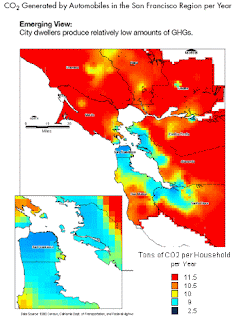Focusing on fleets and personal transportation is very important because these sectors comprise 27% of the US total emissions. However, in order to truly reduce fuel emissions from the transportation sector, we need to create green, alternative ways of getting around to truly give people the sustainable choice to reduce their emissions. Doing so requires a holistic approach to emissions reduction.
A substantial part of reducing the emissions generated by transportation lies in creating dense, walkable communities linked by public transit.
Higher fuel efficiencies for our vehicles, while a great start, are not enough. According to a recent report from UC Berkeley, even a vehicle that gets 55 miles per gallon (like the Toyota Prius and many hybrid-electric models currently on the market) still consumes 30% of our available annual energy budget. Consuming 100% of this budget, as driving an average of 6,000 miles annually with a vehicle earning 12 m.p.g., would mean that we have already taken up the level of carbon emissions considered "sustainable". Any emissions beyond this point, such as those involved in any other process of everyday life, would directly contribute to global warming.
Studies have indicated that denser, walkable communities are as effective at reducing greenhouse gas emissions as raising the fuel efficiency of our cars. Indeed, some development experts already believe that a majority of Americans would choose such communities if they were available.
For a detailed list of systemic changes to urban design and planning to reduce our emissions, please check out the analysis from WorldChaging here and here.


No comments:
Post a Comment